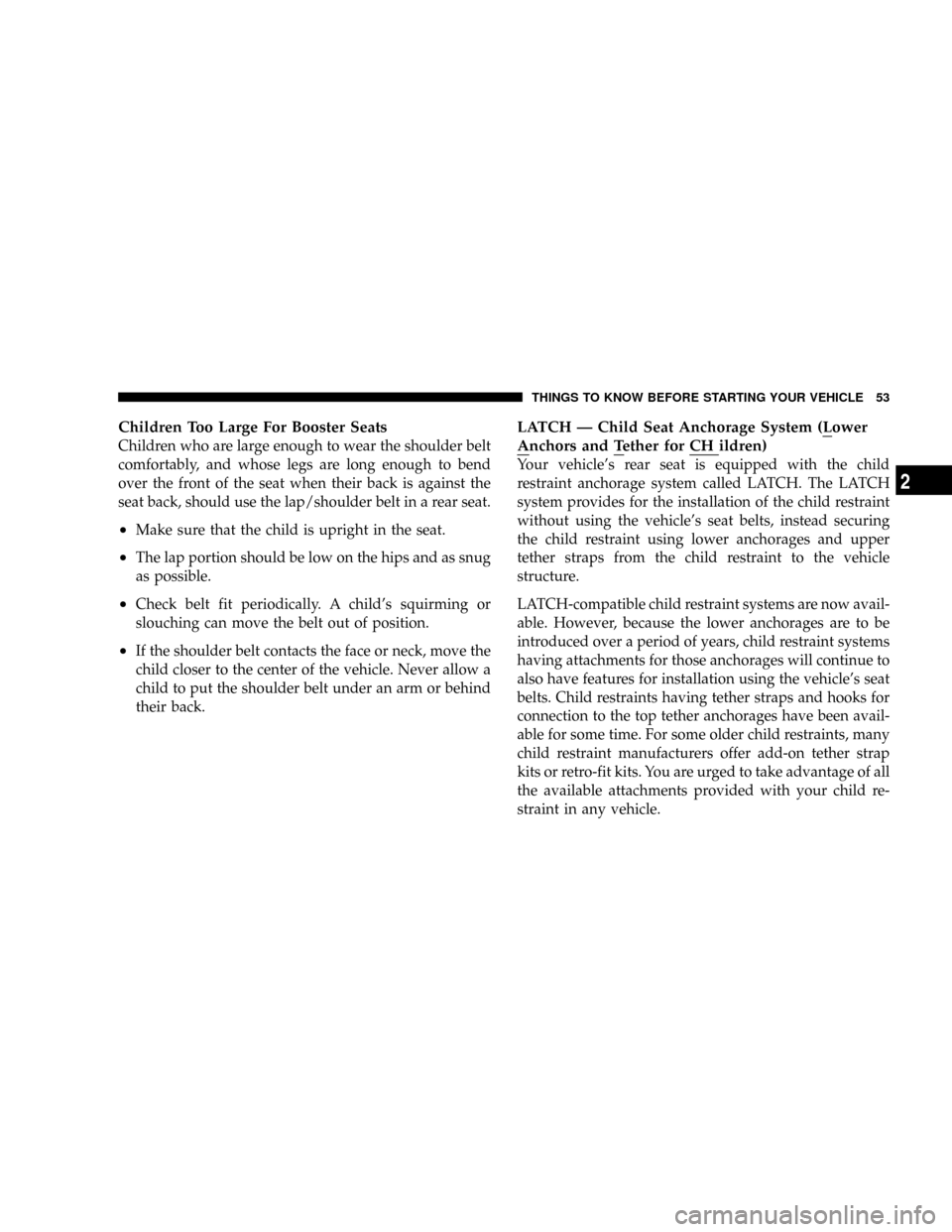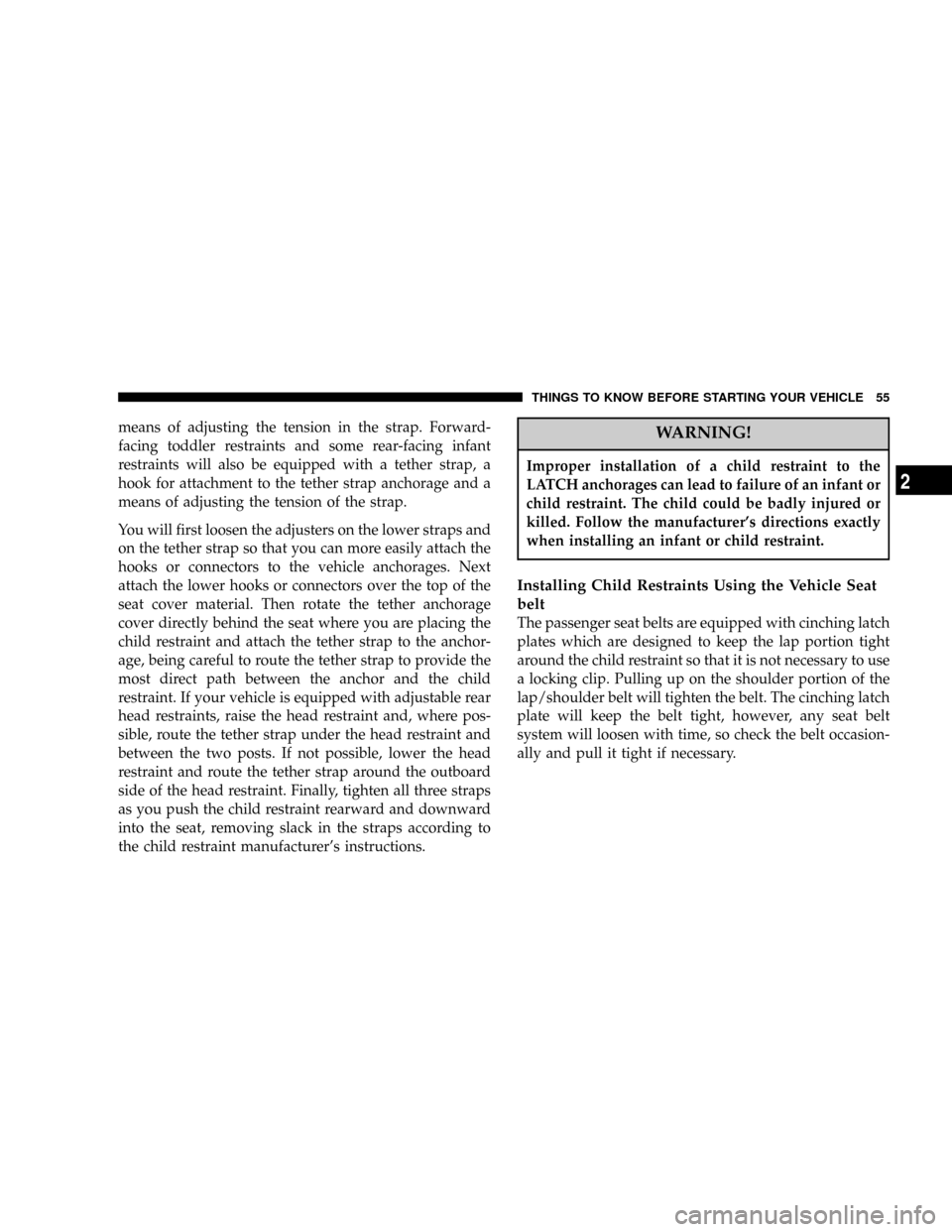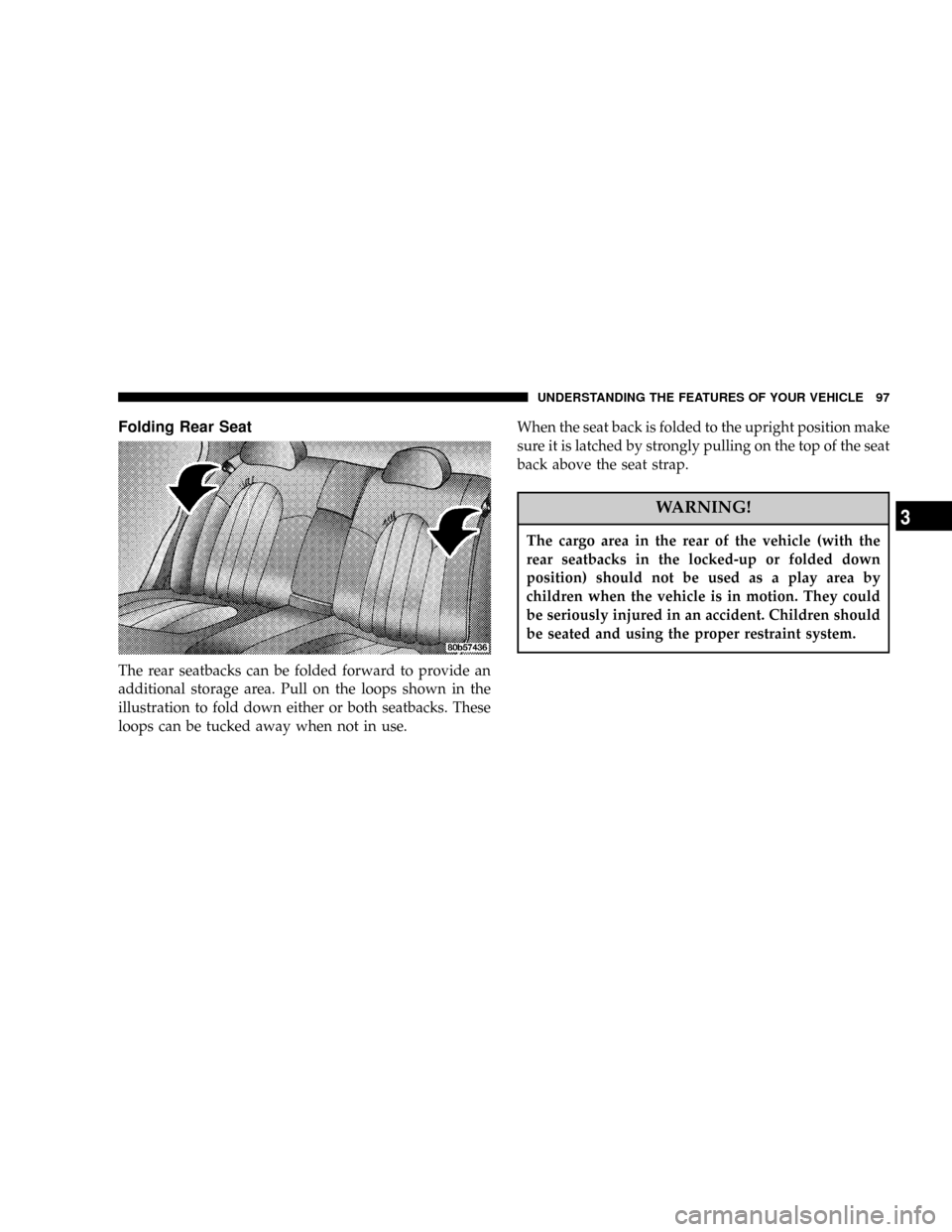2005 CHRYSLER 300 child restraint
[x] Cancel search: child restraintPage 53 of 374

Children Too Large For Booster Seats
Children who are large enough to wear the shoulder belt
comfortably, and whose legs are long enough to bend
over the front of the seat when their back is against the
seat back, should use the lap/shoulder belt in a rear seat.
²Make sure that the child is upright in the seat.
²The lap portion should be low on the hips and as snug
as possible.
²Check belt fit periodically. A child's squirming or
slouching can move the belt out of position.
²If the shoulder belt contacts the face or neck, move the
child closer to the center of the vehicle. Never allow a
child to put the shoulder belt under an arm or behind
their back.
LATCH Ð Child Seat Anchorage System (Lower
Anchors and Tether for CH ildren)
Your vehicle's rear seat is equipped with the child
restraint anchorage system called LATCH. The LATCH
system provides for the installation of the child restraint
without using the vehicle's seat belts, instead securing
the child restraint using lower anchorages and upper
tether straps from the child restraint to the vehicle
structure.
LATCH-compatible child restraint systems are now avail-
able. However, because the lower anchorages are to be
introduced over a period of years, child restraint systems
having attachments for those anchorages will continue to
also have features for installation using the vehicle's seat
belts. Child restraints having tether straps and hooks for
connection to the top tether anchorages have been avail-
able for some time. For some older child restraints, many
child restraint manufacturers offer add-on tether strap
kits or retro-fit kits. You are urged to take advantage of all
the available attachments provided with your child re-
straint in any vehicle.
THINGS TO KNOW BEFORE STARTING YOUR VEHICLE 53
2
Page 54 of 374

All three rear seating positions have lower anchorages
that are capable of accommodating LATCH-compatible
child seats. You shouldNEVERinstall LATCH-
compatible child seats such that two seats share a com-
mon lower anchorage. If installing child seats in adjacent
rear-seating positions or if your child restraints are not
LATCH-compatible, install the restraints using the vehi-
cle's seat belts.Installing the LATCH-Compatible Child Restraint
System
We urge that you carefully follow the directions of the
manufacturer when installing your child restraint. Not all
child restraint systems will be installed as described here.
Again, carefully follow the installation instructions that
were provided with the child restraint system.
The rear seat lower anchorages are round bars, located at
the rear of the seat cushion where it meets the seat back,
and are just visible when you lean into the rear seat to
install the child restraint. You will easily feel them if you
run your finger along the intersection of the seatback and
seat cushion surfaces.
In addition, there are tether strap anchorages
behind each rear seating position located in the
panel between the rear seat back and the rear
window. These tether strap anchorages are
under a plastic cover with this symbol on it.
Many, but not all restraint systems will be equipped with
separate straps on each side, with each having a hook or
connector for attachment to the lower anchorage and a
54 THINGS TO KNOW BEFORE STARTING YOUR VEHICLE
Page 55 of 374

means of adjusting the tension in the strap. Forward-
facing toddler restraints and some rear-facing infant
restraints will also be equipped with a tether strap, a
hook for attachment to the tether strap anchorage and a
means of adjusting the tension of the strap.
You will first loosen the adjusters on the lower straps and
on the tether strap so that you can more easily attach the
hooks or connectors to the vehicle anchorages. Next
attach the lower hooks or connectors over the top of the
seat cover material. Then rotate the tether anchorage
cover directly behind the seat where you are placing the
child restraint and attach the tether strap to the anchor-
age, being careful to route the tether strap to provide the
most direct path between the anchor and the child
restraint. If your vehicle is equipped with adjustable rear
head restraints, raise the head restraint and, where pos-
sible, route the tether strap under the head restraint and
between the two posts. If not possible, lower the head
restraint and route the tether strap around the outboard
side of the head restraint. Finally, tighten all three straps
as you push the child restraint rearward and downward
into the seat, removing slack in the straps according to
the child restraint manufacturer's instructions.WARNING!
Improper installation of a child restraint to the
LATCH anchorages can lead to failure of an infant or
child restraint. The child could be badly injured or
killed. Follow the manufacturer's directions exactly
when installing an infant or child restraint.
Installing Child Restraints Using the Vehicle Seat
belt
The passenger seat belts are equipped with cinching latch
plates which are designed to keep the lap portion tight
around the child restraint so that it is not necessary to use
a locking clip. Pulling up on the shoulder portion of the
lap/shoulder belt will tighten the belt. The cinching latch
plate will keep the belt tight, however, any seat belt
system will loosen with time, so check the belt occasion-
ally and pull it tight if necessary.
THINGS TO KNOW BEFORE STARTING YOUR VEHICLE 55
2
Page 56 of 374

In the rear seat, you may have trouble tightening the
lap/shoulder belt on the child restraint because the
buckle or latch plate is too close to the belt path opening
on the restraint. Disconnect the latch plate from the
buckle and twist the short buckle-end belt several times
to shorten it. Insert the latch plate into the buckle with the
release button facing out.
If the belt still can't be tightened, or if by pulling and
pushing on the restraint loosens the belt, you may need
to do something more. Disconnect the latch plate from
the buckle, turn the buckle around, and insert the latch
plate into the buckle again. If you still can't make the
child restraint secure, try a different seating position.
To attach a child restraint tether strap:
1. Rotate the cover over the anchor directly behind the
seat where you are placing the child restraint.2. Route the tether strap to provide the most direct path
for the strap between the anchor and the child seat. If
your vehicle is equipped with adjustable rear head
restraints, raise the head restraint and, where possible,
route the tether strap under the head restraint and
between the two posts. If not possible, lower the head
restraint and pass the tether strap around the outboard
side of the head restraint.
56 THINGS TO KNOW BEFORE STARTING YOUR VEHICLE
Page 57 of 374

3. Attach the tether strap hook (A) of the child restraint to
the anchor (B) and remove slack in the tether strap
according to the child restraint manufacturer's instruc-
tions.
WARNING!
An incorrectly anchored tether strap could lead to
increased head motion and possible injury to the
child. Use only the anchor positions directly behind
the child seat to secure a child restraint top tether
strap.
Transporting Pets
Airbags deploying in the front seat could harm your pet.
An unrestrained pet will be thrown about and possibly
injured, or injure a passenger during panic braking or in
a collision.
Pets should be restrained in the rear seat in pet harnesses
or pet carriers that are secured by seat belts.
ENGINE BREAK-IN RECOMMENDATIONS
A long break-in period is not required for the engine in
your new vehicle.
Drive moderately during the first 300 miles (500 km).
After the initial 60 miles (100 km), speeds up to 50 or 55
mph (80 or 90 km/h) are desirable.
While cruising, brief full-throttle acceleration, within the
limits of local traffic laws, contributes to a good break-in.
Wide open throttle acceleration in low gear can be
detrimental and should be avoided.
The engine oil installed in the engine at the factory is a
high quality energy conserving type lubricant. Oil
changes should be consistent with anticipated climate
conditions under which vehicle operations will occur.
The recommended viscosity and quality grades are
shown in Section 7 of this manual. NON-DETERGENT
OR STRAIGHT MINERAL OILS MUST NEVER BE
USED.
THINGS TO KNOW BEFORE STARTING YOUR VEHICLE 57
2
Page 97 of 374

Folding Rear Seat
The rear seatbacks can be folded forward to provide an
additional storage area. Pull on the loops shown in the
illustration to fold down either or both seatbacks. These
loops can be tucked away when not in use.When the seat back is folded to the upright position make
sure it is latched by strongly pulling on the top of the seat
back above the seat strap.
WARNING!
The cargo area in the rear of the vehicle (with the
rear seatbacks in the locked-up or folded down
position) should not be used as a play area by
children when the vehicle is in motion. They could
be seriously injured in an accident. Children should
be seated and using the proper restraint system.
UNDERSTANDING THE FEATURES OF YOUR VEHICLE 97
3
Page 363 of 374

Ball Joints............................ 301
Battery............................... 297
Jump Starting........................ 273
Keyless Transmitter Replacement.......... 23
Location.........................274,298
Bearings.............................. 311
Belts, Drive........................... 295
Body Mechanism Lubrication.............. 301
B-Pillar Location....................... 232
Brake Assist System..................... 112
Brake, Parking......................... 222
Brake System.......................224,307
Anti-Lock........................... 225
Fluid Check......................309,334
Hoses.............................. 308
Warning Light....................... 142
Brake/Transmission Interlock.............. 221
Break-In Recommendations, New Vehicle...... 57
Bulb Replacement...................... 323
Bulbs, Light........................... 322
Calibration, Compass.................... 151
Capacities, Fluid....................... 332Caps, Filler
Fuel............................... 254
Radiator............................ 305
Car Washes........................... 312
Carbon Monoxide Warning............... 253
Cargo Tie-Downs....................... 131
Cassette Tape and Player Maintenance....... 192
Catalytic Converter..................... 296
CD Player......................159,164,175
Cellular Phone.......................... 68
Chains, Tire........................... 248
Changing A Flat Tire.................... 265
Chart, Tire Sizing....................... 229
Child Restraint...................50,52,54,55
Child Restraint Tether Anchors............. 54
Child Safety Locks....................... 19
Clean Air Gasoline...................... 251
Climate Control........................ 194
Clock................................ 158
Compact Disc Maintenance............... 193
Compact Spare Tire..................... 239
Compass............................. 150
Compass Calibration.................... 151
INDEX 363
10
Page 367 of 374

Hood Release.......................... 99
Hoses............................307,310
Ignition
Key ................................ 11
Illuminated Entry....................... 15
Immobilizer............................ 12
Infant Restraint......................... 50
Information Center, Vehicle............... 147
Instrument Cluster................138,139,140
Instrument Panel and Controls............. 137
Instrument Panel Lens Cleaning............ 314
Interior Appearance Care................. 313
Interior Fuses.......................... 315
Interior Lights......................... 101
Intermittent Wipers..................... 108
Introduction............................ 4
Jack Location.......................... 267
Jack Operation......................266,269
Jacking Instructions..................... 269
Jump Starting......................... 273Key, Programming....................... 14
Key, Replacement....................... 13
Key, Sentry............................ 12
Key-In Reminder........................ 12
Keyless Entry System..................... 20
Keys................................. 11
Knee Bolster........................... 37
Lap/Shoulder Belts...................... 30
LATCH (Lower Anchors and Tether
for CHildren)........................... 54
Latch Plate............................ 31
Latches
Hood............................... 99
Lead Free Gasoline...................... 250
Lights.............................59,101
Airbag.........................41,58,142
Anti-Lock........................... 141
Automatic Headlights.................. 104
Brake Warning....................... 142
Bulb Replacement..................322,323
Courtesy/Reading.................... 101
Daytime Running..................... 104
INDEX 367
10